Enhancing Local Disaster Management Network through Developing Resilient Community in New Taipei City, Taiwan
Abstract
1. Introduction
2. Materials and Methods
2.1. Study Area
2.2. Steps of Promoting Resilient Community
2.2.1. Step 1. Start-Up Meeting
2.2.2. Step 2. Activation Workshop
2.2.3. Step 3. Site Survey and Strategy Development Workshop
- Sorting photo: During the site survey, photos are taken and printed. Participants are asked to sort out the photos into two categories, i.e., disasters hotspot and resource points.
- Mapping Photo: Those photos sorted in the previous step are pasted on the aero map with stickers near the photo. If the photo is a disaster hotspot, its condition, such as the location and cause/effect of the potential disaster is written down on the stickers; if the photo is a resource point, its function is described.
- Strategy discussion: With possible disaster conditions and resource points at hand, the expert will help participants discuss strategies to deal with issues from the perspective of the individual, the community, and the local government level. For example, trash sometimes jams the gutter and causes flooding; therefore at the individual level, every resident should be made aware of not dropping trashes in the gutter; at the community level, residents should team up to clean the gutter regularly especially before the flooding season; at the local government level, district office can ask the cleaning contractors to dredge the cutter or provide the community with equipment needed to clean it. Local enterprises and schools can be invited to discuss their role as outer resources to help the community respond to disasters.
- Experience sharing: The goal of this workshop is to finalize valid strategies mainly by the community; therefore, resident representatives are asked to report the discussed strategies to all the participants and try to reach consensus.
2.2.4. Step 4. Resilient Community Response Team and Action Plan Workshop
Community Response Team
Community Action Plan
- Environmental and disaster risk assessment
- 2.
- Community response team and local disaster management network
- 3.
- Resources inventory and management
- 4.
- Sustainable operation mechanism
- (1)
- Regular training: It defines the courses and skill training to behold and its frequency;
- (2)
- Community disaster management database update: It includes the response team member recruitment/retirement, vulnerable residents list update, and equipment maintenance frequency;
- (3)
- Disaster processing record: The community should record the action taken pre-disaster, in-disaster, and post-disaster. It helps review the community action as well as identify defects and weak points of the plan.
2.2.5. Step 5. Education and Training Workshop
2.2.6. Step 6. War Game or Drill
- Scenarios must correspond to community characteristics in terms of single disaster or complex disaster.
- Self-protection skills of individuals could be exercised, such as “Drop”, “Cover”, “Hold On” during the earthquake.
- The disaster scale should be designed properly so that the community must and could react. If the scale is too small, then no significant damage will highlight the necessity for community response; if the scale is too large, most community members might lose their capability due to casualties resulting in malfunction of the team.
- Every division in the community response team should have the chance to familiarize themselves with their tasks and required skills.
- Coordination and communication among the response team, stakeholders, and public/private agencies should be tested.
- The community should understand the evacuation routes to the shelter as well as arrange and test the transportation for evacuation.
- Collaboration between the district office and the community team to open the shelter should be exercised.
2.2.7. Step 7. Exhibition of Resilient Community
2.3. Questionnaire Survey
3. Results
3.1. Performance Survey
3.2. Successful Cases of Community Operation
3.2.1. Jiaqing Village—Preparedness before the Typhoon Event
3.2.2. Baiyun Village—Responding to a Local Landslide Event
4. Discussion
4.1. Obstacles and Solutions
4.1.1. Phase 1: Resilient Community 1.0 (2009–2015)
Insufficient Willingness
Environmental Variety
Time-Consuming and Financial Concern
Various Authority Concerned
4.1.2. Phase 2: Resilient Community 2.0 (2016–2017)
4.1.3. Phase 3: Resilient Community 3.0 (2018~)
4.2. Suggested Maintenance Mechanism of Resilient Community
4.2.1. Retraining Courses
- Tasks review of the community response team: New members will join the community response team now and then. It is of great importance to make sure each member, whether senior or newcomer, knows his/her task well.
- Collection and reporting of disaster information: With the popularization of smartphones, more apps are available for collecting disaster information and uploading it to the cloud platform. The community should learn which technical tool is more suitable to the community and how it functions. All disaster information collected could be reserved in a community database for future review.
- Advanced disaster response skills: Basic skills such as CPR, Heimlich maneuver, and fire extinguisher operation were taught while developing a resilient community. Advanced skills, such as patient moving, escape from the fire scene, and responding with the tool at hand (e.g., making slippers with old newspapers; making simple toilets with paper box and plastic bag) are suggested in the retraining courses. Considering the COVID-19 pandemic in 2020, epidemic prevention is also suggested to be included in the retraining. Thereby, every trainee could be a community watcher and help spread epidemic prevention knowledge and support the government’s action if necessary. The selection of skills is not limited to specific disaster types that the community is most likely to confront. The advanced skill training aims to make the community function in an all-hazards response manner.
- War game: Every disaster management action plan should be periodically reviewed and tested. At the community level, war game is a less costing and less time-consuming way to validate the plan compared to drill. However, the design of a proper war game is still not easy for the community. They should deeply consider the potential risk and transform it into disaster scenarios for strategy discussion. They will also have to manage inner resources and seek additional outer resources. Usually, inviting experts or public sector personnel to join the war game would help the community deliver more insightful outcomes.
4.2.2. Equipment Subsidization
4.2.3. NTPC Resilient Community Certificates
- Environmental risk assessment: The identification of disaster potential and associated strategies must be delivered.
- Community disaster management database: Including the identification of vulnerable people in the community, inventory of equipment, list of community residents with special skills and who can help respond to disaster, and contact list of outer resources such as police department, fire department, volunteer, school and enterprise.
- Community response team: Including the head and crew of the five-response team divisions. It is batter if the enterprise and school can join as a support division.
- Skill training: Including basic skills introduced in Section 2.2.5.
- Drill: Including the script with properly designed disaster scenarios and the actual role-playing of 5 team divisions.
4.2.4. Tracking Community Performance
- Mitigation: Including routine education, skill training, drill/war game, environment patrol, disaster information;
- Preparedness: Including hosting preparedness meeting, equipment inventory, real-time weather monitoring and early warning, checking vulnerable people’s condition and need, patrolling areas prone to disasters, and shelter opening preparedness;
- Report in: Once the disaster is spotted, reporting to the community and the authority concerned for timely response, as well as to associated private sectors such as water company or power company for assistance;
- Response: Including dealing with disasters such as removing fallen trees, fire-fighting, identifying risk area and setting up cordon; evacuating people in the high-risk area; helping public sectors such as opening shelter, traffic control, and setting up command post; taking care of wounded by first-aid, caring for, and moving patients;
- Recovery: Including environment cleaning, recovery, and rebuilding.
5. Limitation and Challenges
5.1. Aging Population.
5.2. Lack of Real Experience
5.3. Insufficient Funding Support
6. Conclusions
Author Contributions
Funding
Acknowledgments
Conflicts of Interest
References
- United Nations Office for Disaster Risk Reduction (UNDRR, formally UNISDR). Sendai Framework for Disaster Risk Reduction 2015–2030. Available online: https://www.preventionweb.net/files/43291_sendaiframeworkfordrren.pdf. (accessed on 1 June 2020).
- Japan Association for Fire Science and Engineering. Fire Investigation of Southern Earthquake in Hyogo Prefecture in 1995, Japan; J.A.F.S.E.: Tokyo, Japan, 1996.
- Kais, S.M.; Islam, M.S. Community Capitals as Community Resilience to Climate Change: Conceptual Connections. Int. J. Environ. Res. Public Health 2016, 13, 1211. [Google Scholar] [CrossRef]
- Adams, R.M.; Eisenman, D.P.; Glik, D. Community Advantage and Individual Self-Efficacy Promote Disaster Preparedness: A Multilevel Model among Persons with Disabilities. Int. J. Environ. Res. Public Health 2019, 16, 2779. [Google Scholar] [CrossRef] [PubMed]
- Reams, M.A.; Irving, J.K. Applying community resilience theory to engagement with residents facing cumulative environmental exposure risks: Lessons from Louisiana’s industrial corridor. Rev. Environ. Health 2019, 34, 235–244. [Google Scholar] [CrossRef] [PubMed]
- Nonomura, A.; Fujisawa, K.; Takahashi, M.; Matsumoto, H.; Hasegawa, S. Analysis of the Actions and Motivations of a Community during the 2017 Torrential Rains in Northern Kyushu, Japan. Int. J. Environ. Res. Public Health 2020, 17, 2424. [Google Scholar] [CrossRef] [PubMed]
- Koebele, E.A.; Crow, D.A.; Albright, E.A. Building Resilience during Recovery: Lessons from Colorado’s Watershed Resilience Pilot Program. Environ. Manag. 2020, 66, 15. [Google Scholar] [CrossRef] [PubMed]
- Iturriza, M.; Hernantes, J.; Abdelgawad, A.A.; Labaka, L. Are Cities Aware Enough? A Framework for Developing City Awareness to Climate Change. Sustainability 2020, 12, 2168. [Google Scholar] [CrossRef]
- Laurien, F.; Hochrainer-Stigler, S.; Keating, A.; Campbell, K.; Mechler, R.; Czajkowski, J. A typology of community flood resilience. Reg. Environ. Chang. 2020, 20, 14. [Google Scholar] [CrossRef]
- National Fire Agency, Ministry of the Interior. Assessment of the Problem and Preparedness of Metropolitan Taipei during a Large Scale Earthquake (in Chinese); N.F.A.: New Taipei City, Taiwan, 2013.
- New Taipei City Fire Department. Resilient community Operation Manual in New Taipei City; T.P.C.F.D.: New Taipei City, Taiwan, 2016. (In Chinese)
- Dwirahmadi, F.; Rutherford, S.; Phung, D.; Chu, C. Understanding the Operational Concept of a Flood-Resilient Urban Community in Jakarta, Indonesia, from the Perspectives of Disaster Risk Reduction, Climate Change Adaptation, and Development Agencies. Int. J. Environ. Res. Public Health 2019, 16, 3993. [Google Scholar] [CrossRef] [PubMed]
- Chen, Y.F. A Case Study of University Involvement in Community-Based Reconstruction: In The Coventry University Model. Community-Based Reconstruction of Society; Hokugo, A., Kaneko, Y., Eds.; Springer: New York City, NY, USA, 2017; pp. 61–66. [Google Scholar]
- Seebauer, S.; Ortner, S.; Babcicky, P.; Thaler, T. Bottom-up citizen initiatives as emergent actors in flood risk management: Mapping roles, relations and limitations. J. Flood Risk Manag. 2019, 12, 17. [Google Scholar] [CrossRef] [PubMed]
- Khorram-Manesh, A. Flexible surge capacity—Public health, public education, and disaster management. Health Promot. Perspect. 2020, 10, 1–5. [Google Scholar] [CrossRef]
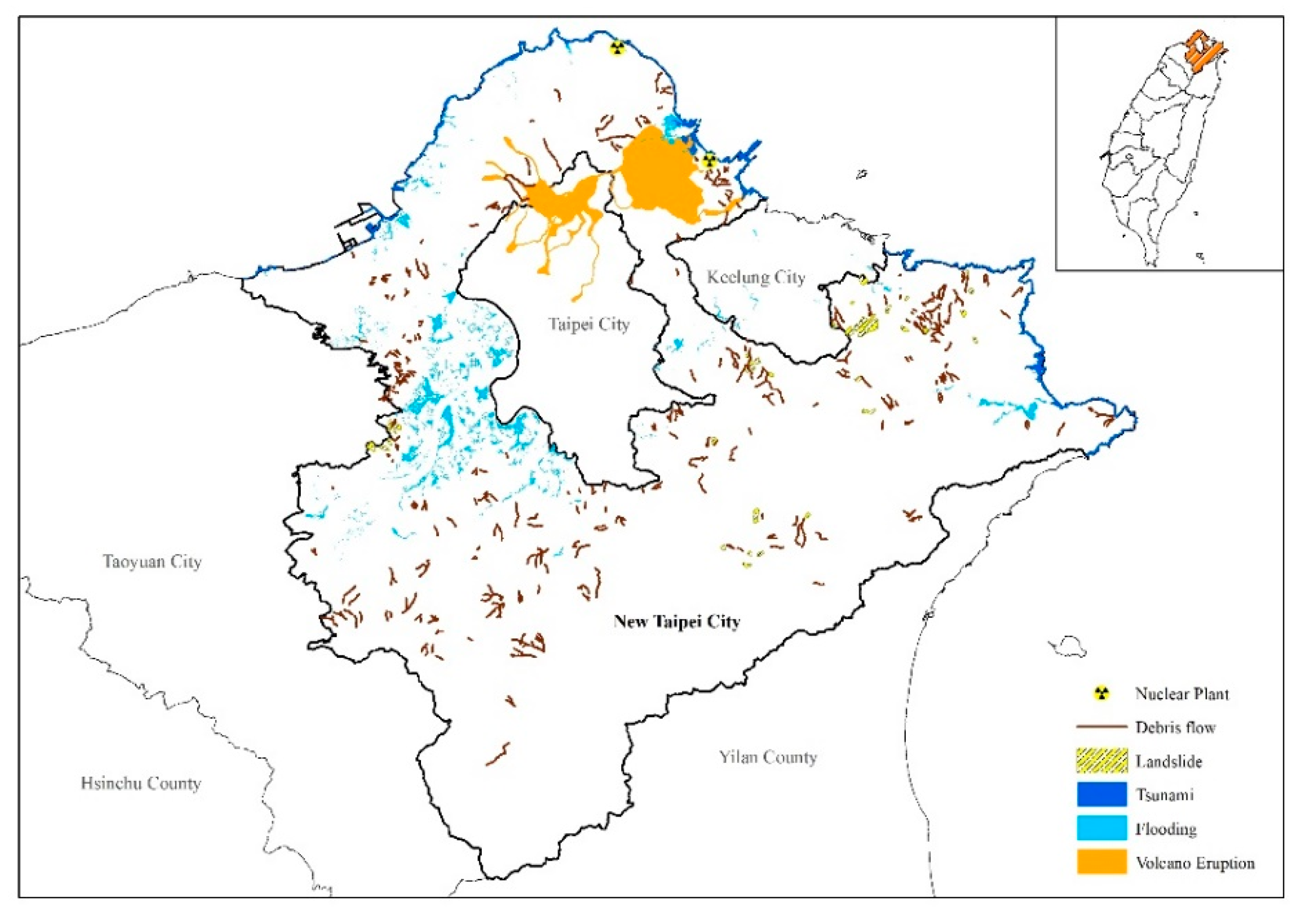
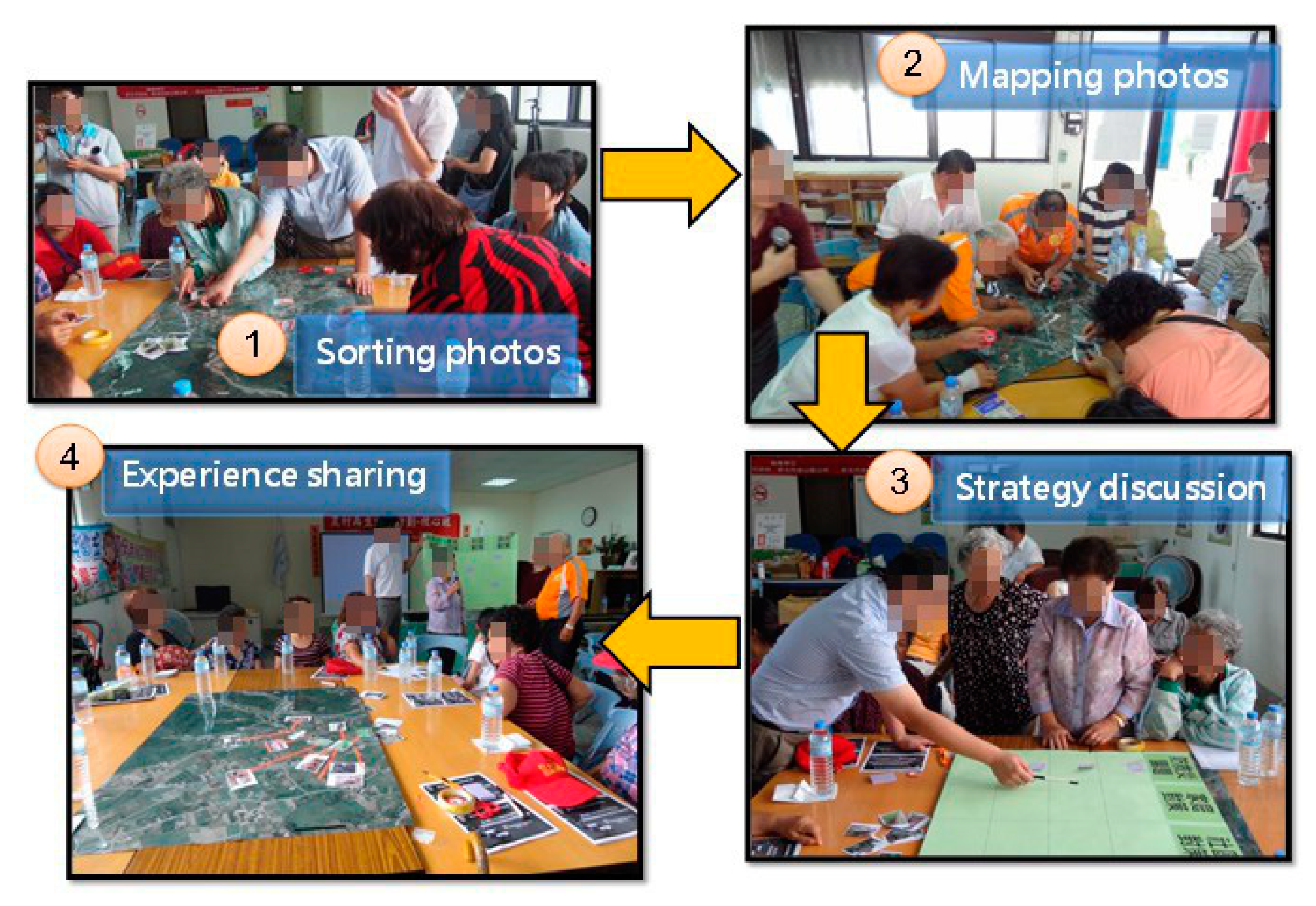
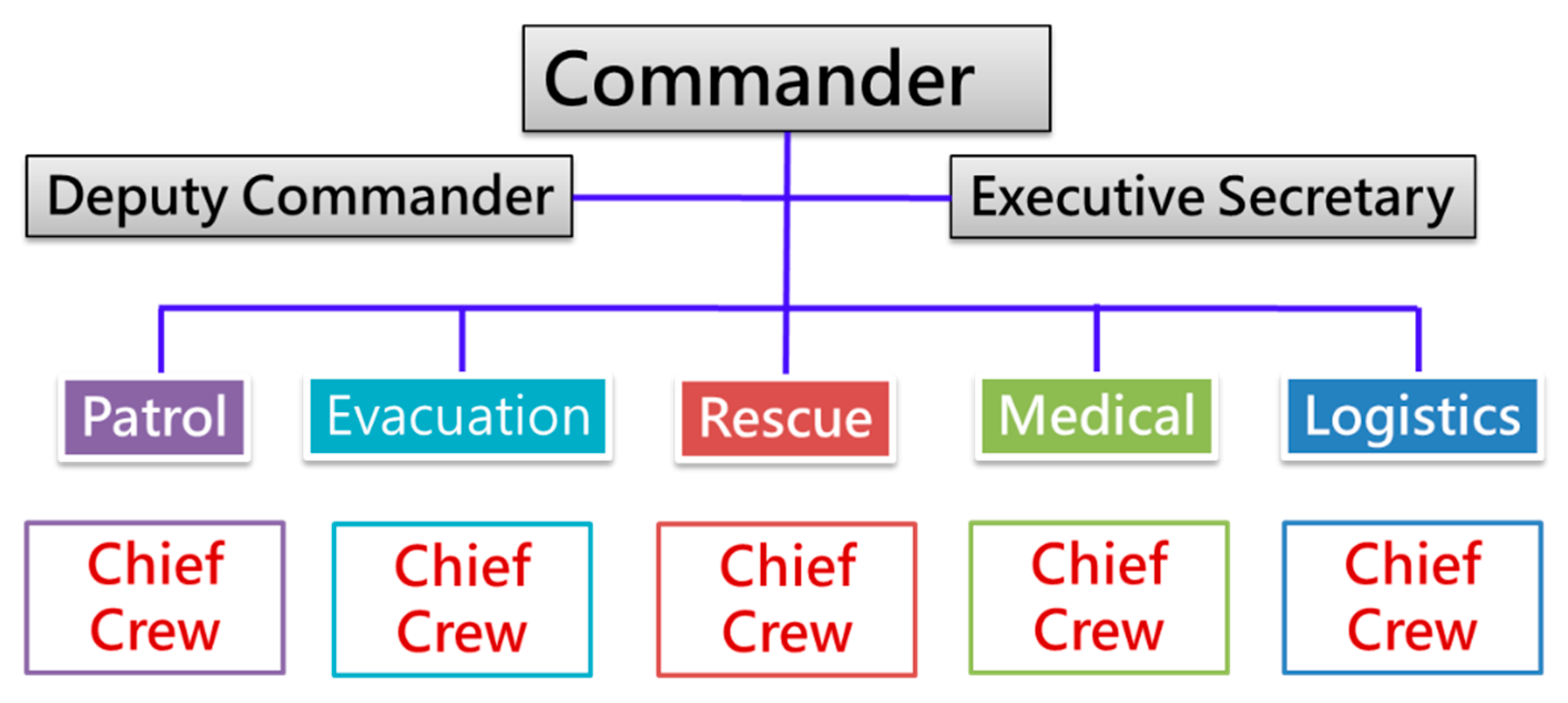
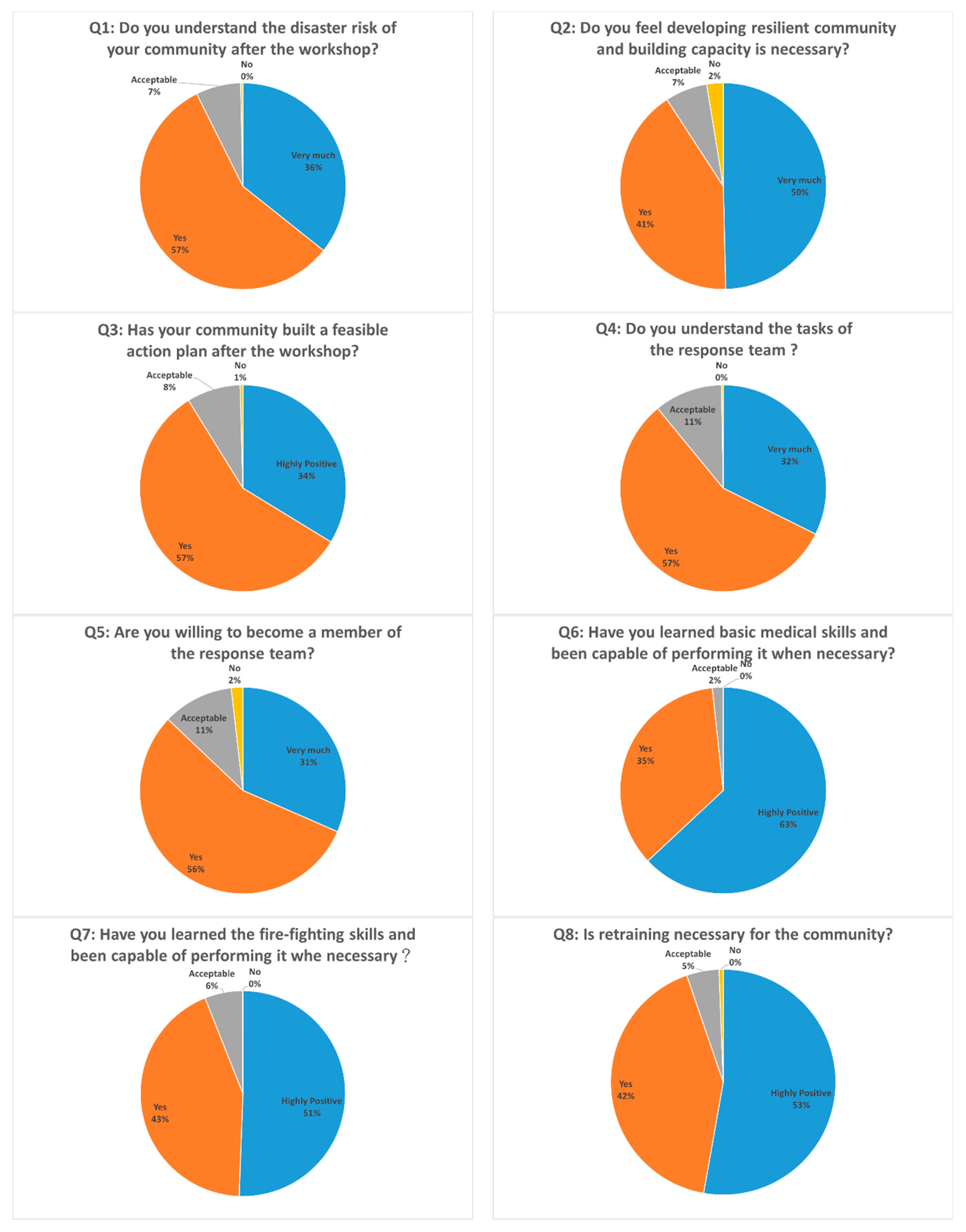
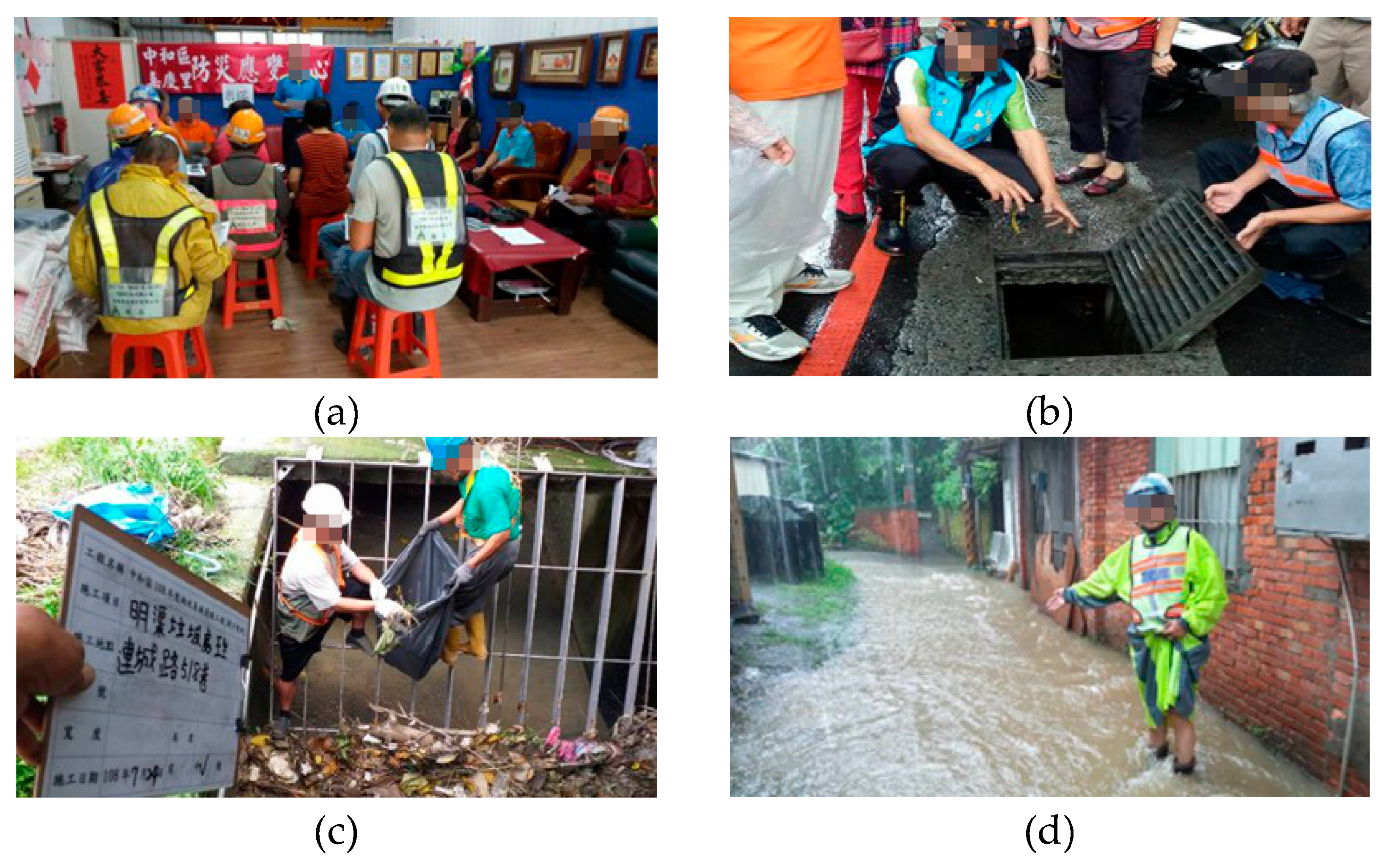

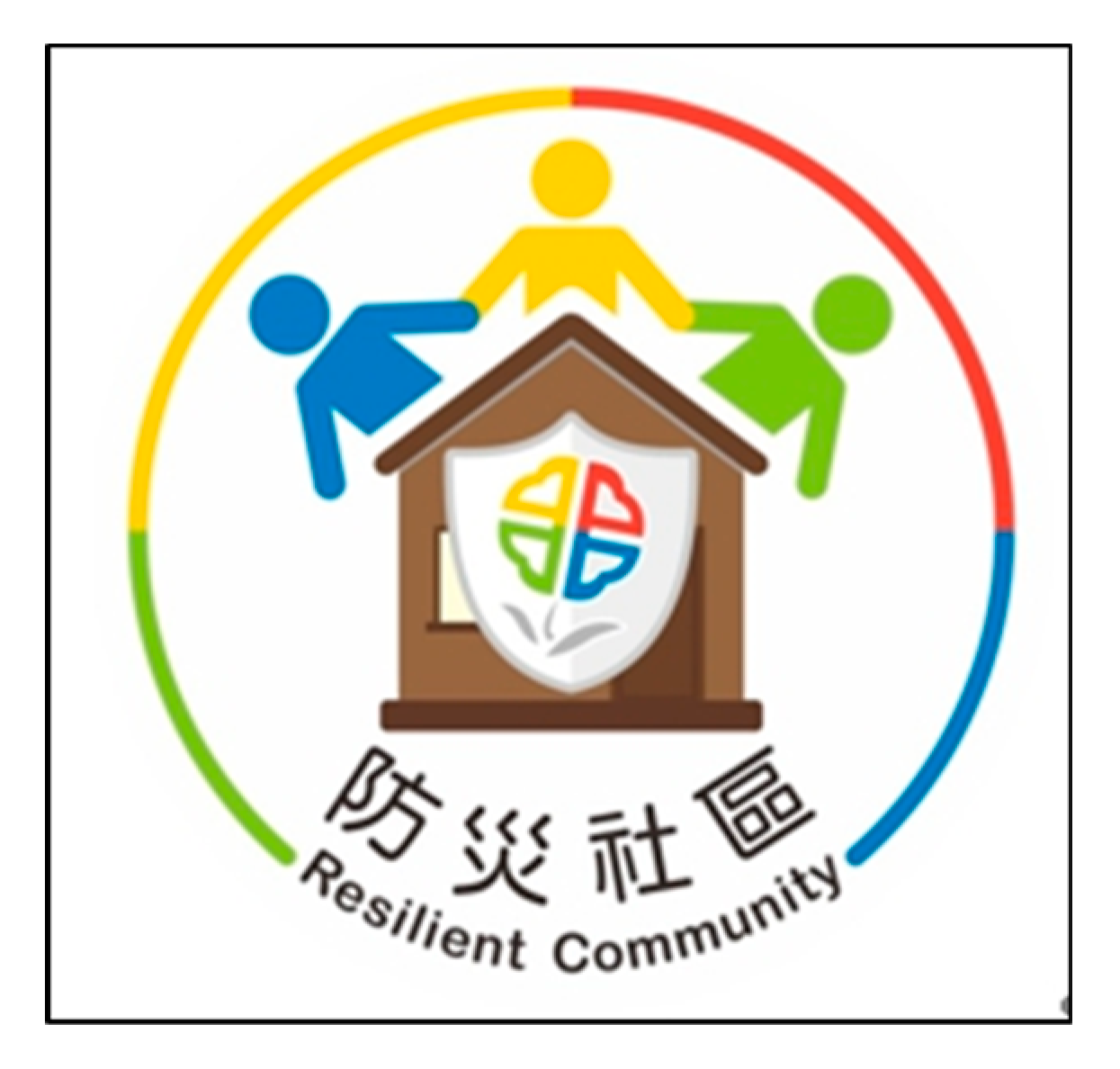
| Team Division | Function | |
|---|---|---|
| Pre-Disaster | In-Disaster and Post-Disaster | |
| Patrol |
|
|
| Evacuation |
|
|
| Rescue |
|
|
| Medical |
|
|
| Logistics |
|
|
| Scenario | Situation |
|---|---|
| Scenario 1 | Self-protection, such as “Drop”, “Cover”, “Hold On” exercise at the time of an earthquake. |
| Scenario 2 | Community response team mobilization and preparedness. |
| Scenario 3 | Preparedness for opening shelter by logistic division. |
| Scenario 4 | The assistance of refugee evacuation to the shelter by evacuation division. |
| Scenario 5 | Patrol division surveys the area and calls for help from the rescue division upon locating damage. |
| Scenario 6 | Assistance by logistics division in shelter opening, such as registration, food sharing, and related operations. Living supply may come from the enterprise. |
| Scenario 7 | First-aiding the physically wounded people or caring for the traumatized people by medical division. |
| Scenario 8 | Rescue division puts out small-scaled fire induced by the earthquake |
| Scenario 9 | Recovering the environment by the entire response team and community residents. |
| Age | ~20 | 21~30 | 31~40 | 41~50 | 51~60 | 61~70 | 71~80 | 81~ |
|---|---|---|---|---|---|---|---|---|
| Number of Participants | 13 | 23 | 48 | 126 | 358 | 441 | 143 | 28 |
| Percentage | 1% | 2% | 4% | 11% | 30% | 37% | 12% | 2% |
| Event: Typhoon Mitag | ||||
|---|---|---|---|---|
| Operation Duration | Location(s) | Operation Type | ||
| Date | Time |
| □Mitigation ■Preparedness □Report in □Response □Recovery | |
| From | 2019.09.30 | 10:00 a.m. | ||
| To | 2019.09.30 | 11:17 a.m. | ||
| Operation Process Note | ||||
| ||||
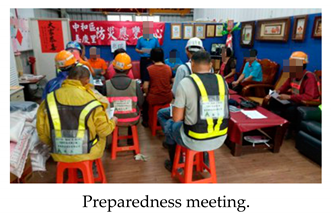 |  | |||
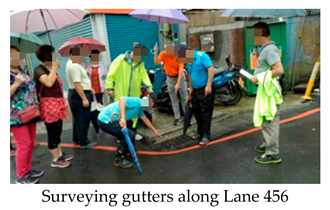 | 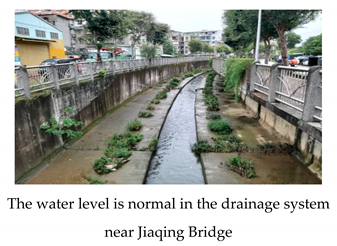 | |||
© 2020 by the authors. Licensee MDPI, Basel, Switzerland. This article is an open access article distributed under the terms and conditions of the Creative Commons Attribution (CC BY) license (http://creativecommons.org/licenses/by/4.0/).
Share and Cite
Ke, K.-Y.; Lin, Y.-J.; Tan, Y.-C.; Pan, T.-Y.; Tai, L.-L.; Lee, C.-A. Enhancing Local Disaster Management Network through Developing Resilient Community in New Taipei City, Taiwan. Int. J. Environ. Res. Public Health 2020, 17, 5357. https://doi.org/10.3390/ijerph17155357
Ke K-Y, Lin Y-J, Tan Y-C, Pan T-Y, Tai L-L, Lee C-A. Enhancing Local Disaster Management Network through Developing Resilient Community in New Taipei City, Taiwan. International Journal of Environmental Research and Public Health. 2020; 17(15):5357. https://doi.org/10.3390/ijerph17155357
Chicago/Turabian StyleKe, Kai-Yuan, Yong-Jun Lin, Yih-Chi Tan, Tsung-Yi Pan, Li-Li Tai, and Ching-An Lee. 2020. "Enhancing Local Disaster Management Network through Developing Resilient Community in New Taipei City, Taiwan" International Journal of Environmental Research and Public Health 17, no. 15: 5357. https://doi.org/10.3390/ijerph17155357
APA StyleKe, K.-Y., Lin, Y.-J., Tan, Y.-C., Pan, T.-Y., Tai, L.-L., & Lee, C.-A. (2020). Enhancing Local Disaster Management Network through Developing Resilient Community in New Taipei City, Taiwan. International Journal of Environmental Research and Public Health, 17(15), 5357. https://doi.org/10.3390/ijerph17155357






